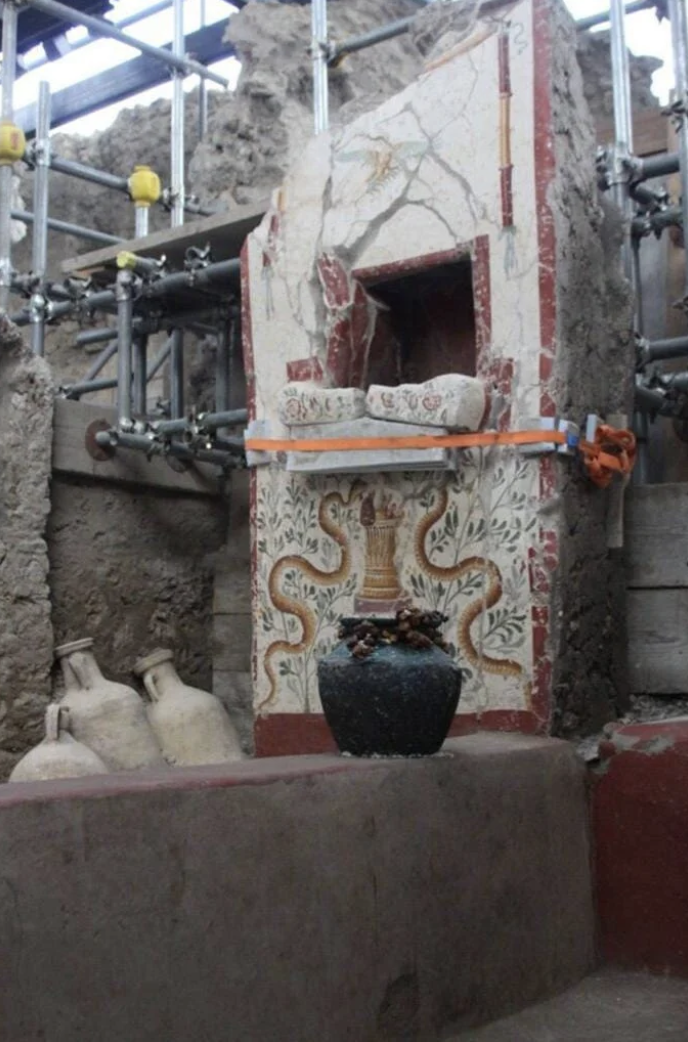Newly Discovered House of Phaedra Reveals Exquisite Artistry in Pompeii!
Archaeologists in Pompeii have recently uncovered the House of Phaedra, a remarkably decorated small home along Via dell’Abbondanza. This intimate residence, modest in size yet rich in art, contains a collection of stunning frescoes that shed light on the tastes, beliefs, and cultural norms of ancient Roman life.
Photo Credit: The Archaeological Park of Pompeii
Hidden Gem: A Tiny Home with Stunning Frescoes
Named after the mythological queen Phaedra, this small home features colourful, mythologically themed frescoes depicting scenes that range from mythical romances to dramatic conflicts. Noteworthy among these are portrayals of Venus and Adonis and a striking fresco illustrating the tragic tale of Phaedra and Hippolytus. In this myth, Phaedra falsely accuses her stepson of assault after he refuses her advances—a scene that captures both the artistic talent and the storytelling of Pompeii’s ancient inhabitants. This type of erotic and provocative imagery was common across Pompeii, decorating both private residences and public spaces, reflecting a more open attitude towards sexuality in Roman society.
Artistic Grandeur in a Compact Space
Despite the home’s size, its interior artistry rivals that of grander Pompeian estates. Interestingly, the House of Phaedra lacks a central atrium—a common feature in Roman homes designed for rainwater collection—hinting at evolving architectural styles during that period. The Archaeological Park of Pompeii highlighted the quality of the frescoes, noting that the house exemplifies how even smaller homes valued artistic richness, blending elements that were both beautiful and culturally meaningful.
Photo Credit: The Archaeological Park of Pompeii
The Cultural Significance of Erotic Art and Symbolism
The discovery of this home offers valuable insights into Pompeii’s social life and artistic trends. The presence of risqué frescoes in a more modest home suggests that bold imagery wasn’t limited to the wealthy; it was embraced across social levels, underscoring Pompeii’s relaxed view of sexuality. The house also features symbolic motifs like a large phallus—believed to represent fertility and prosperity—further emphasising how common and culturally accepted these symbols were within the community.
At the entrance, archaeologists also found a small altar painted with floral and animal motifs, along with remnants of a lamp and an incense burner, hinting that the house was under renovation when Mount Vesuvius erupted in 79 CE. This tragic eruption buried Pompeii in volcanic ash, inadvertently preserving its detailed frescoes and offering a glimpse into the daily lives of its residents.
Photo Credit: The Archaeological Park of Pompeii
Adding Depth to Pompeii’s Story
The House of Phaedra is the latest addition in a series of recent discoveries that enhance our understanding of ancient Pompeian life. Gabriel Zuchtriegel, director of the Archaeological Park of Pompeii, reflected on how these vibrant, detailed scenes would come alive under the flickering light of oil lamps, especially after gatherings that included plenty of local Campanian wine.
Through the House of Phaedra and other ongoing finds, Pompeii continues to share its story, offering modern audiences a window into its once-vibrant world that artfully blends tragedy, beauty, and daily life.
Photo Credit: The Archaeological Park of Pompeii



